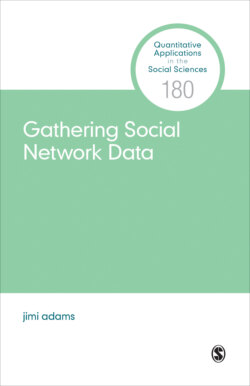Читать книгу Gathering Social Network Data - jimi adams - Страница 12
На сайте Литреса книга снята с продажи.
Motivating Network Research
ОглавлениеYou’re beginning a new research project that has a network focus and are beginning to think about how to gather the data you’ll need. Maybe you’ve been studying insurance companies for years and developed the intuition that they mimic one another’s policies but haven’t had the data needed to show what determines which organizations adopt strategies from which others versus which strike out on their own. Or perhaps you’re an epidemiologist who wants to trace the spread of a new Ebola outbreak through a population, in the hope of curtailing how many people are infected in this—and future—outbreaks. Or, while consulting on a political campaign, you want to determine more accurately which of our friends and family members most strongly influence our own voting behaviors; with that information, maybe you could then design targeted advertising that optimizes how to leverage these patterns to the benefit of your candidate.
Each of these questions has a network aspect to it. That means to answer these types of questions precisely and accurately, you need data on the ties linking the individual people (or organizations) to one another. How would you go about gathering those data?
In virtually any social science discipline, new grad students are shuttled through a research design course basically as soon as they arrive.3 Given those tools, it may seem plausible that gathering network data is not really any different from what’s been required to gather details on an individual’s age, gender, educational background, or behavioral profile. Or, if organizations are your focus, and you’ve been examining their internal leadership characteristics and institutional histories, it may seem that turning your attention to how these organizations are linked to one another simply requires asking a few more questions beyond those you typically include.
3 As a result, this book generally assumes the reader has a basic foundation in social science research methods. This allows what follows here to build on, rather than replicate, the extensive literature available on best practices in social scientific research methods. I highlight where a network perspective modifies the general principles of social science in ways that require network-specific adaptations. In case they are helpful, I provide a few recommendations of resources for general social science research methods in Appendix A.
But, as you’ll see in the chapters that follow, studying networks requires more than simply adding some relationship variables to an already extensive set of individual-level characteristics. In fact, some have argued that studying social networks requires altering the paradigm of social science altogether [Berkowitz, 1982]. Given this difference, the next section provides an overview of some of the conceptual and theoretical ways that network research differs from these more familiar general social scientific approaches. This discussion of how network research “thinks” differently, in turn, sets up the corresponding methodological approaches that I describe in the chapters that follow.
Given the breadth of theoretical perspectives represented in the field, two caveats are necessary. First, it will likely be the case for most readers that only a subset of the ideas here will apply to the types of questions you have in mind. As such, don’t worry about fitting each of these ideas into your own research areas. Find the ones that do work for you, and maybe the others will spark questions for a later time. Regardless of the type(s) of questions you identify as your own, each of the perspectives described here will have direct ramifications for the methodological considerations in the chapters that follow. Second, I necessarily cover each of these theoretical perspectives in a somewhat cursory fashion. My aim is to show the implications of these perspectives for the aims of this book—namely, how to gather network data.4
4 I often tell my students that my courses aren’t sufficient for them to walk away with their expertise in an area. Instead, they’re designed to help them begin developing that expertise by laying the foundations, then helping them identify where they’d like to dig deeper on their own, and providing the language and broad roadmap for how to do that additional digging. My approach in the remainder of this chapter echoes this same approach.
So, before diving into the larger aims of the book on gathering network data, this chapter will begin by outlining several of the theoretical perspectives that animate social networks research, to emphasize why network data are important. In other words, following Lin Freeman’s (2004) suggestion that network methods are the necessary result of a variety of relational theoretical principles, we begin with an overview of those theoretical perspectives. This will also entail a discussion of some of the most common types of ties these theories suggest we are likely to gather data about.
